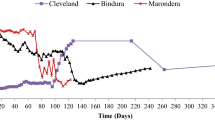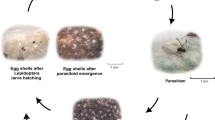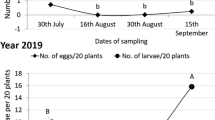Abstract
Since it was first reported in Tanzania in 1981 the Larger Grain Borer (LGB) has spread from a small area in the northwest of the country to 17 of the 20 regions. Only in the extreme south, along the Mozambique border, has the pest not been found. It has also become established in Kenya, Burundi, Togo and Benin.
LGB can cause very high weight loss in farm stored maize and dried cassava, commodities on which it if able to breed. After 5 months storage during the dry season in western Tanzania, mean losses of 9% were found, a much higher level than losses of less than 1 % which would be expected in LGB-free areas in East/Central Africa.
Application of 0.5% permethrin dust at 2.8 ppm provides excellent protection against LGB when applied to loose maize grain for 1 year. However, the storage of shelled maize predisposes towards the development of Sitophilus species which can result in high losses being sustained. A ”cocktail“ of permethrin and pirimiphos-methyl, applied at 3.3 and 17.7 ppm respectively, successfully controls all storage pests and is currently being used in an extensive control campaign in Tanzania.
A multi-donor funded control and containment campaign, co-ordinated by FAO, has been in operation in Tanzania since 1984. The programme is comprised of a training element for agricultural staff and several field extension campaigns which assist with insecticide distribution and with dissemination of information to farmers. The primary objectives of the programme are to reduce farm storage losses and to contain LGB within the areas it is now found. In some regions, where LGB is relatively isolated, attempts are being made to eradicate it.
Résumé
Depuis qu’il a èté signalé pour la première fois dans le Nord-Est de la Tanzanie en 1981, le Prostephanus truncatus (Horn) s’est repandu dans 17 des 20 pays de la region; exepte dans l’extrême Sud, le long de la frontiere mozambicaine. Le P. truncatus s’est etabli aussi au Kenya, Burundi, Togo et Benin. Il peut cause dans les champs des pertes enormes du mais et manioc sèché stockés (aliments dans lesquels ils se multiplient). Apres 5 mois de stockage pendant la saison sèche en Tanzanie les pertes moyennes moyennes etaient de 9%, pourcentage tres elèvé par rapport au moins de 1% constantees dans les zones du centre et de l’Est Africain non infectees par P. truncatus. L’usage de 0,5% de poudre de permethrin a 2,8 ppm prouvait une excellente protection du mais, pendant un an contre P. truncatus. Par ailleurs, la conservation du mais egrené favorise le developpement de l’espèce Sitophilus qui peut causer des pertes enormes. Un ”cocktail“ de permethrin et pirimiphos-methyl, mis a usage a 3,3 et 17,7 ppm peut controler avec succes tous les ravageurs dans les entrepôts et est actuellement utilisé dans des campagnes de lutte extensive en Tanzanie. Une campagne de lutte financée par plusieurs donateurs et coordonnée par la FAO a ete en operation en Tanzanie depuis 1984. Le programme comprend la formation du personnele agricole et plusieurs campagnes de vulgarisation sur le terrain pour faciliter la distribution des insecticides et la dissemination de l’information aux planteurs. Les objectifs primaires du programme sont: reduire les pertes pendant le stockage en champ et contenir le P. truncatus dans les zones ou il se trouve actuellement. Dans certaines regions ou il est relativement isole, des tentatives d’irradication sont faites.
Similar content being viewed by others
References
Bengston M., Connell M., Davies R. A. H., Desmarchelier J. M., Phillips M. P., Snelson J. T. and Sticka R. (1975) Fenitrothion plus (1R)-phenothrin, and pirimiphosmethyl plus carbaryl, as grain protectant combinations for wheat. Pestic. Sci. 11, 471–482.
Dunstan W. R. and Magazini I. (1981) Outbreaks and new records in Tanzania. The larger grain borer on stored products. FAO Plant Prol. Bull. 29, 80–81.
Evans N. J. (1985) The effectiveness of various insecticides on some resistant beetle pests of stored products from Uganda. J. stored Prod. Res. 212, 105–109.
Golob P., Changjaroen P., Ali M. A. and Cox J. (1985) Susceptibility of Prostephanus truncatus to insecticides. J. stored Prod. Res. 21, 141–150.
Golob P. and Hodges R. J. (1982) Study of an outbreak of Prostephanus truncatus (Horn) in Tanzania. Report G.164. Tropical Products Institute, London.
Hodges R. J., Dunstan W. R., Magazini I. and Golob P. (1983) An outbreak of Prostephanus truncatus (Horn) (Coleoptera, Bostrichidae) in East Africa. Prol. Ecol. 5, 183–194.
Hodges R. J., Cork A. and Hall D. R. (1984) Aggregation pheromones for monitoring the greater grain borer, Prostephanus truncatus. British Crop Protection Conference—Pests and Diseases, Brighton, November 1984, pp. 255–260.
Hodges R. J., Meik J. and Denton H. (1985) Infestation of dried cassava (Manihot esculenta Crantz) by Prostephanus truncatus (Horn) (Coleoptera, Bostrichidae). J. stored Prod. Res. 21, 73–77.
Howard D. C. (1983) The population biology of the greater grain borer Prostephanus truncatus (Horn). Ph.D. thesis. University of Reading, U.K.
Kega V. K. and Warui C. W. (1983) Prostephanus truncatus in Coast Province, Kenya. Trop, stored Prod. Inf. 46, 2.
Krall S. (1984) A new threat to farm-level maize storage in West Africa: Prostephanus truncatus (Horn) (Coleoptera, Bostrichidae). Trop. stored Prod. Inf. 50, 26–31.
Shires S. W. (1977) Ability of Prostephanus truncatus (Horn) (Coleoptera, Bostrichidae) to damage and breed on several food commodities. J. stored Prod. Res. 13, 205–208.
Shires S. W. (1979) Influence of temperature and humidity on survival, developmental period and adult sex ratio in Prostephanus truncatus (Horn) (Coleoptera, Bostrichidae). J. stored Prod. Res. 15, 5–10.
Author information
Authors and Affiliations
Rights and permissions
About this article
Cite this article
Golob, P. Current Status of the Larger Grain Borer Prostephanus truncatus (Horn) in Africa. Int J Trop Insect Sci 9, 737–745 (1988). https://doi.org/10.1017/S1742758400005622
Received:
Published:
Issue Date:
DOI: https://doi.org/10.1017/S1742758400005622




